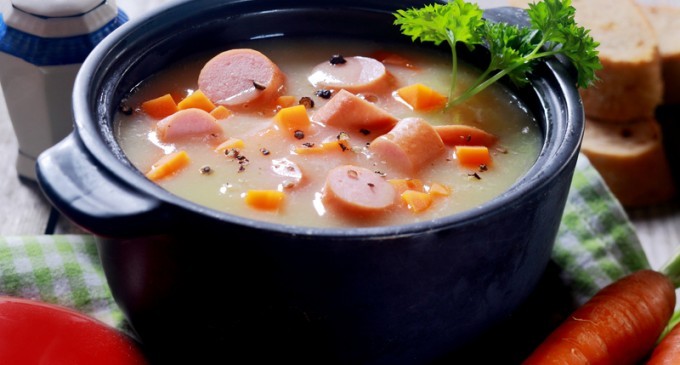
I may not have graduated yet to making my own broth, but I have figured out how to make soup work. Soup is one of the most ancient and classic meals of all time, across all cultures. If you can get soup right, you will truly feel like a ninja in the kitchen. So for those days when you have a bunch of random stuff in your kitchen and want soup without leaving the house or using a recipe, here are some tips to get it right!
1. Start with a solid base
This means start with a good broth! Obviously, homemade broths are the best, the second best is butcher's broth. However, just using broth in general is the first way to make sure your soup has a decent taste. It is much easier to build on the flavor. When I started trying to make soups, I thought I was saving money by just using a water base, then adding a bunch of seasoning. I would end up using half my spices, and still the soup tasted bland. For me, this was the most frustrating part. So, I buckled down and I started getting broth to start off my soups. That way, even if I screw it up a bit, it still stands a chance. Vegetable broth is just as delicious as chicken broth (even more so, in some opinions) so give that one a chance for sure.
Take stock of your stock: When it comes to making clear, brothy soups, the stock that you use is the most important ingredient. Poorly flavoured stock will ruin the entire pot of soup. For clear soups, homemade broth is always the best choice. If that isn’t an option for you, purchase butcher’s broth instead of grocery store brands.
Visit Chatelaine for more great tips!
2. Up your seasoning game
As I mentioned above, seasoning is not my strength. I wanted to find ways to use less seasoning, but still have great taste. After one particularly failed attempt at bringing one of my homemade creations to share with my soup-expert co-worker, she gave me one of the absolute best tips of all time:
“Layer your seasoning.”
Ladies and gentleman this tip is the one that I need for you to take away from this above all. Layer your seasoning! (Again, I apologize to any elite kitchen dwellers who see this as common sense.)
Don't be me. Don't throw it all in a pot of water and then hope for the best at the end. Layering your seasoning means adding spice and salt as you go and not just at the end. Another great tip she gave me that probably many of you know? Taste your soup as you go. Don't be like me and assume the soup tastes like it smells. Just because the aroma of garlic is coming from your stove-top, does not mean your soup will taste like garlic.
Still unsure? Don't worry, I found a loophole to the whole seasoning dilemma: Paprika.
Paprika is the miracle spice if you ask me, and one of the best ways to spice up your vegetable soup. Paprika is a red pepper that is ground into a spice and unlike cayenne, paprika's flavor is less hot and offers more of a deep, smoky flavor that’s so nice. This makes it more palatable and won’t burn your tongue unless you use too much. Usually about ½ tsp. per pot of soup is just about right. It adds this deep smoky and slightly spicy flavor that is absolutely wonderful.
Another great loophole are bay leaves! Let them float around for a bit for easy flavor.
Visit All Woman's Talk for awesome tips!
3.Avoid Over-salting
This brings me to one of the most common mistakes people make when making soup: Too much salt! This particular factor has caused me too much stress to even talk about, when it comes to making soup. I know I said to layer your seasoning, meaning you can salt as you go, but not too much! I nearly gave up on all of my soup-making dreams, until I found this tip: Add Potato. If you don't have potato, try pasta. As a last resort just add more broth or water and keep trying! If you are feeling risky, natural herbs such as thyme and rosemary also help.
If your soup still ends up tasting a little salty, first try adding a few more cups of broth or water. This will thin out your soup – and the salt. You can eat it like this, or you can add a potato or two to absorb some of the extra liquid (and yes, its salt!). A cup of rice or some pasta will accomplish the same end.
More ideas can be found at The Kitchn.
4. Get the veggies right
Remember the “stuff floating around in a bath of hot water” metaphor? This is the kind of soup we want to avoid. It's not true, what they say. You can not just chop up what you have and throw it in a pot. There are techniques and stuff. For instance, celery cooks quickly, so it is best to put it in the end so it will not get soggy. However, onion and garlic should be sauteed beforehand so that their flavor comes out.
More advice from Chatelain
To make a good soup, you have to build flavours as you go. Vegetables like onion, garlic, celery and carrots–referred to as ‘aromatics’–are part of most soup recipes for this very reason, sautéed in oil or butter as a first step of flavour-making. Be sure they’re cooked long enough to be softened before moving on to the next step.
5. Find your right texture
We have all been there, I hope. Let me tell you about a time I made soup and it was going really well. The flavors were all mixing, the salt was in check and everything just looked totally legit. Then, I get the idea that this would make a really delicious creamy soup. The chill outside called for something comforting and I had a guest coming over that I was super excited to share my soup with. Allow me to tell you what NOT to do to thicken your soup:
I. Do not add flour to your soup
II. Do not add cold milk to your soup
My mistake was the former. I added flour to my soup and it did not get very thick. I did not think much of it and served it anyway. But wait! I didn't put potato in the soup, did I? Those are not potatoes, they are clumps of flour floating around and violating the epic masterpiece that was once my soup. Of course my guests would still comment on how tasty it was, as they dodged soggy clumps in an attempt for a decent bite. Don't do it!
As for milk, warm it first unless you are making homemade cottage cheese stew.
Here is what you Can do for a creamier soup:
I. Add yogurt
II. Add ground nuts
III. Puree a portion of the soup
IV: Add flour (or starch) – The Right Way!
Starches thicken soup and give it body. Whisk a few tablespoons of starch into a little of the broth in a separate bowl before whisking it into the main pot. This prevents the starch from clumping and helps it dissolve into the soup evenly.
More at The Kitchn!
You see? Soup is not that scary after-all. I really love creamy soups, so getting that right was not easy. I also love a lot of flavor, so I would go nuts with seasoning, and then that is all you would taste. Now, I feel pretty confident that I could walk in to my kitchen and produce a pretty decent bowl of soup, maybe even one I could bring to work!
Do you have any other tips to share?


There are no comments at the moment, do you want to add one?
Write a comment